Do You Have To Change Soil In Potted Plants
HuffPost may receive a share from purchases made via links on this page. Prices and availability subject to change.
As we programme for a summer of social distancing, you lot may accept tried to bring the outdoors in by ordering a few more than houseplants or starting an indoor garden filled with fruits and veggies. Later all, plants have been known to make people feel happier and calmer, and can fifty-fifty help purify the air.
Only like all skilful things, plants crave work, patience and attending.
I of the secrets to transforming your space into a lush greenhouse starts with knowing bones constitute intendance similar repotting. Repotting is an easy way to refresh your plants by giving them some more room to grow (and you can too spruce up your space with some pretty new planters).
If you're a new plant parent — or worse, take a reputation for having a brownish pollex — learning how to go along a institute alive is no easy task. From figuring out the best time of year to repot plants to knowing which soil is right for them, there'south a lot to wrap your head around when it comes to repotting plants later on buying them.
We talked to found experts from well-known greenspaces similar The Sill , Bloomscape and Niggling Shop of Soil for tips on how to properly repot plants and everything you demand to practise it properly.
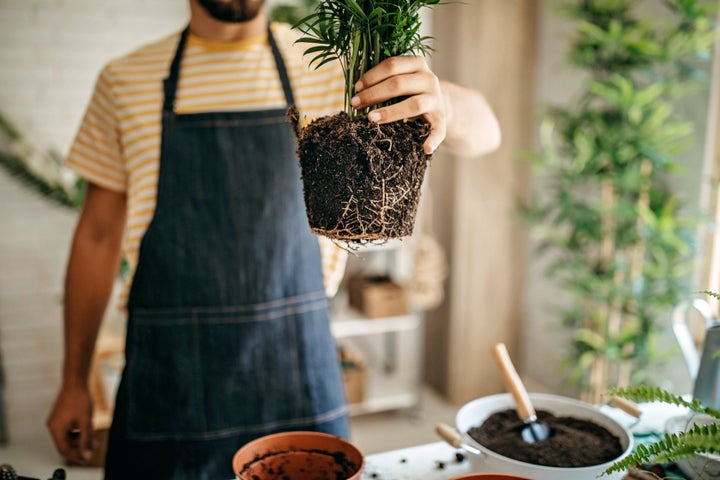
eclipse_images via Getty Images
When to repot plants after ownership them
You lot probably don't want to repot a plant right subsequently you get information technology. If you simply got a new plant that's nonetheless in the container it came in, the experts agree you should give it a few days or even weeks to acclimate to your abode before transferring it to a different planter.
You may be interested in putting your found into a stylish new planter that matches your decor. Simply one of the biggest reasons you would want to repot a plant is to give it fresh soil, according to Erin Marino , the manager of brand marketing at The Sill .
"Repotting your plant does non necessarily mean changing a plant'due south electric current planter, but rather, irresolute its soil or potting mix because fresh soil ways new nutrients," Marino told HuffPost Finds.
Another reason y'all might want to repot a plant? If information technology has grown too big for its current pot — i.due east., information technology'due south root-bound. If the plant'southward roots accept taken up all of the space and begun growing through the lesser of the pot, it's time for a new dwelling house, according to Richard Pham , manager of Little Shop of Soil in Bushwick, Brooklyn.
"Repotting is a stressful fourth dimension for a plant, so try not to do it too often. Let the constitute speak to you. Information technology will tell you when information technology's ready for a new abode."
- Richard Pham
Pham said there are a few symptoms of root-leap and pot-bound plants to look out for: the roots are peeking out from the drainage holes, the plant tin can easily exist lifted or fall out of the pot, you see more roots than soil, the plant dries out faster than usual, or it'south been over a year since the constitute was last repotted.
"Repotting is a stressful time for a plant, and then endeavor not to exercise information technology too often," Pham said. "Allow the establish speak to you. It will tell you when it'southward prepare for a new abode."
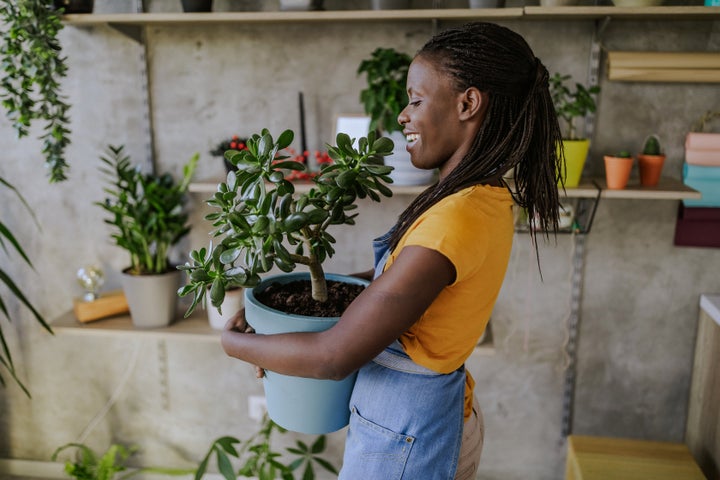
Pekic via Getty Images
Buying the perfect planter
If your plant isn't root-bound but does need a refresh, stick to a pot that's similar in size to the container the plant was in previously. For plants that have outgrown their electric current pots, size up well-nigh one to ii inches to ensure there's room for growth, Marino said.
Figuring out how to repot a large plant isn't much dissimilar. For larger, floor-sized plants, you'll likely desire to size upwardly 3 to 4 inches, depending on how much you lot desire information technology to grow.
Planter size is important because you tend to water a plant more when you motion it to a larger pot with more than soil, Marino said. If you have a minor establish in an oversized planter , all that water will be wetting the dirt and not reaching the roots, which can lead to overwatering and possibly root rot. Instead, it's ameliorate to size upwardly gradually over the years.
Make sure the pot you are switching to has a hole in the bottom for excess water to bleed onto a saucer, said Joyce Mast , resident Institute Mom (and the founder's real mom) at Bloomscape . A institute in a pot without drainage is much more susceptible to root rot, damage and even decease from overwatering.
If information technology doesn't have a drainage pigsty, Marino recommends layering the lesser of the planter with lava rocks or gravel to create a space for water to pool away from the plant's roots.
Finally, what materials are best for establish pots? Pham said almost plants volition do good from whatsoever fabric that is porous and wicks away moisture, like terra cotta . Certain plants, like ferns and calatheas, that relish more than moisture might prefer a plastic or ceramic pot.
"Plastic and ceramic pots don't dry out equally fast and so I'k able to go along up with watering all my plants," Pham said. "Once yous reach a certain number of plants, you'll observe little tricks that help you along the manner."
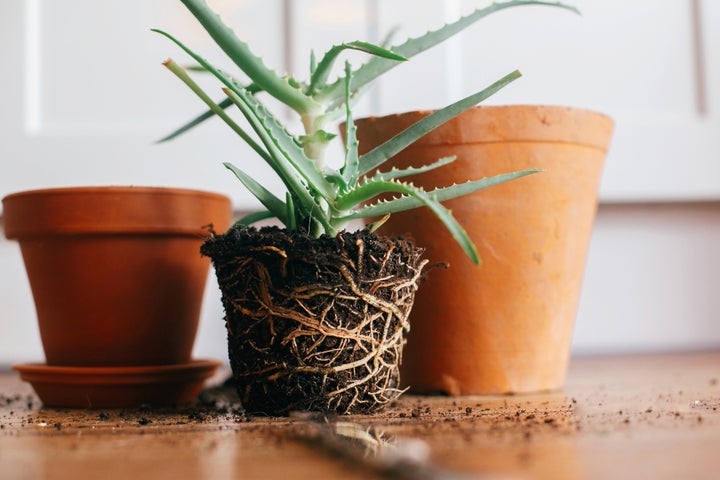
Bogdan Kurylo via Getty Images
How to repot a plant without killing information technology
To remove a plant from its current pot, turn the plant sideways, hold it gently past the stems or leaves, and tap the bottom of its container until the plant slides out. You might need to give the base of operations of the stems a couple of light tugs to get the establish out.
"Loosen the plant's roots with your hands," Marino said. " If your plant is root-bound — the roots are growing in very tight circles around the base of operations of the plant — unbind the roots as best yous can and requite them a trim."
Cutting dorsum any dead, mushy, discolored or excessively long roots with sharp scissors or pruning shears rids the plant of useless roots, Mast said. She also recommends wiping the blades with rubbing alcohol between each snip to avoid spreading bacteria between the roots.
Mast likewise recommends avoiding repotting in extreme weather similar a heat wave, since doing so tin can add stress to the constitute.
" Water your plants a day or two ahead of time so the roots are well-hydrated to avoid root shock," she said. "Never repot if a establish is wilted due to underwatering. Offset hydrate, so repot."
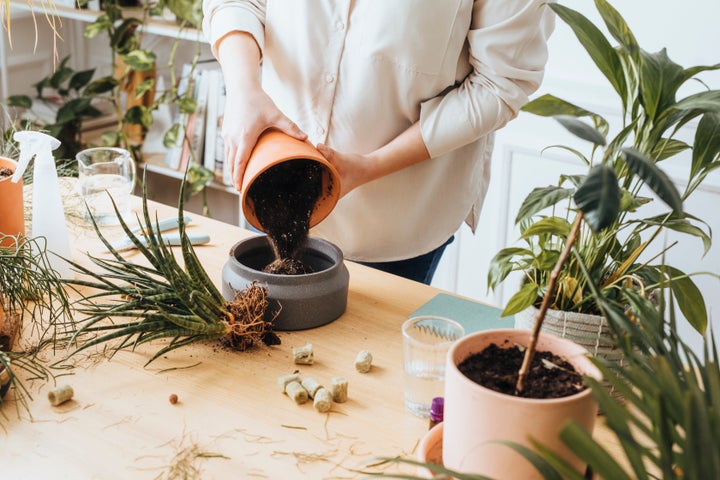
FreshSplash via Getty Images
How to add new soil to a potted found
When your plant is ready for a refresh, remove nearly one-3rd or more of its potting mix. Plants blot a lot of nutrients equally they grow, so they need fresh soil from fourth dimension to time. Cascade a layer of fresh potting soil into the new planter and pack it down, removing any air pockets. Merely don't pack it also tight — you want the roots to exhale.
The experts hold you can unremarkably use any indoor potting mix , but Marino usually avoids annihilation that has an extra benefit like "moisture control" that might throw off her usual plant-care routine.
If your institute is healthy, you don't need to remove all the onetime soil, Pham said. Just loosen the soil on the bottom of the plant so the roots tin freely abound. Fill in any gaps, especially on the bottom and sides of the pot, with the fresh soil.
"I always similar mixing in some of the old soil into the new soil when repotting," Pham said. "My reasoning is that the quondam soil has microbes that the plant has gotten used to and helps give the plant a familiarity to its new domicile and soil."
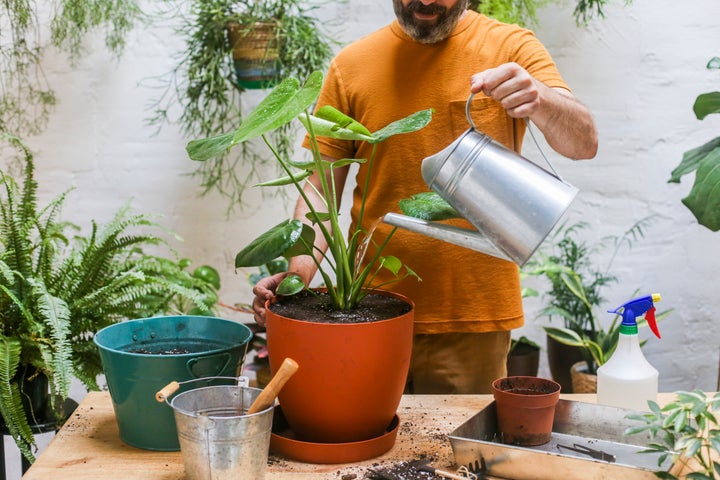
Cavan Images via Getty Images
How often should you water indoor plants?
How frequently you h2o your plant can vary week to week and fifty-fifty calendar month to calendar month — it all depends on your plant and your home, according to Pham.
After repotting, however, your plant volition require a thorough watering to settle into its new pot. Water it until the h2o flows freely from the lesser of the plant. Allow the plant to "residuum" then all the h2o drains from the pot before placing information technology on its new saucer. (Yous don't want puddling h2o.)
"I recommend the touch test," Mast said. "Button your finger into the soil until information technology reaches your eye knuckle. If the soil feels moist to the touch on, do non h2o your plants and check again in a few days."
Typically, the problem isn't how much h2o you use to h2o a plant — it's watering something too oft. Focus on making certain the water is evenly distributed throughout the pot and soil. Use a watering can if you have it. It'll help the water come out as a soft steady stream and helps with distribution.
"When h2o comes out of the drainage pigsty, that's your cue to stop watering," Pham said.
"When water comes out of the drainage hole, that's your cue to cease watering."
- Richard Pham
Apply a moisture meter to track watering large firm plants. If you actually desire to captivate, keep track of your watering and how your plants react so you can pick up on any patterns. (Pham, who has over 130 plants, uses a spreadsheet.)
Information technology doesn't really matter what fourth dimension you water your plants, Marin said, but if you desire to become into a routine, she recommends the mornings: "That mode your plants can bulk up on water before the sun is shining in total strength."
In general, most tropical plants require water every ane to 2 weeks, while succulents merely demand h2o every 3 to four weeks. Both might crave more frequent waterings in the summertime with more daily light, and less frequent waterings in the winter with less daily light.
Still want more than guidance on keeping your houseplants live? Below, nosotros've rounded up all of experts' recommendations into one easy-to-browse slideshow, so you have everything you need to go repotting.
Everything you need to repot plants, below:
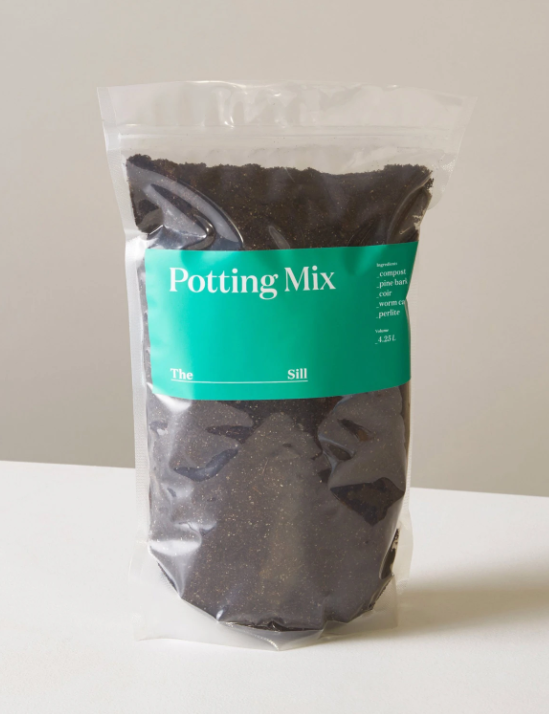
Everything You Need To Properly Repot Plants, According To Pro Gardeners
Source: https://www.huffpost.com/entry/how-to-repot-a-plant-without-killing-it_l_5edfde7dc5b6511b7939ae56
Posted by: smithmoused1964.blogspot.com


0 Response to "Do You Have To Change Soil In Potted Plants"
Post a Comment